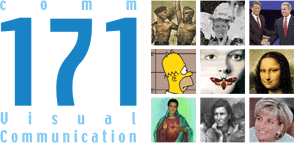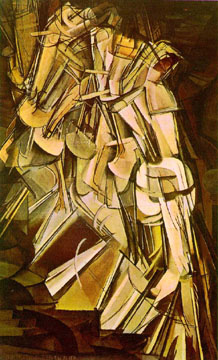
Office: HGH 210; phone: (408) 924-5378
Email: wooda@email.sjsu.edu
Web: http://www.sjsu.edu/faculty/wooda
 |
Dr. Andrew Wood Office: HGH 210; phone: (408) 924-5378 Email: wooda@email.sjsu.edu Web: http://www.sjsu.edu/faculty/wooda |
Reading:
Sturken, M, & Cartwright, L. (2001). Practices of looking: An introduction to visual culture. New York: Oxford University Press.
| Note: These comments are not designed to "summarize" the reading. Rather, they are available to highlight key ideas that will emerge in our classroom discussion. As always, it's best to read the original text to gain full value from the course. |
 Examine
Marcel Duchamp's painting, Nude Descending a Staircase. Unveiled at the
1913 Armory Show, Duchamp's radical creation provoked the notion that artistic
representation need not be either literal or symbolic. One may, instead, display
several dimensions of space simultaneously to enact time as a form of poetic,
intertextual sculpture. Rather than depict a languid figure subject to time,
resting in a single location between moments, Duchamp crafts a human figure
in multiple dimensions, constructed by jagged planes, who glides into the foreground
in several moments at once. In many ways, this image illustrates the changing
ways in which the image reflects social understandings of time, space, and experience.
Examine
Marcel Duchamp's painting, Nude Descending a Staircase. Unveiled at the
1913 Armory Show, Duchamp's radical creation provoked the notion that artistic
representation need not be either literal or symbolic. One may, instead, display
several dimensions of space simultaneously to enact time as a form of poetic,
intertextual sculpture. Rather than depict a languid figure subject to time,
resting in a single location between moments, Duchamp crafts a human figure
in multiple dimensions, constructed by jagged planes, who glides into the foreground
in several moments at once. In many ways, this image illustrates the changing
ways in which the image reflects social understandings of time, space, and experience.
In Chapter Four (109-150), the authors explore the changing ways in which visual communication seeks to depict the world. Comparing the relatively flat planes of Egyptian papyrus drawings to the perspective-based artworks of the Renaissance, the authors propose that perspective introduces an ideal spectator to the scene. This creation of a certain vantage-point from with the image may be encountered situates the spectator in a "god's eye" perspective. So what? Well, the notion of perspective, inspired by scientific forms of measurement, allows artists and viewers to imagine themselves at the center of the world's creation-reproduction. One can imagine significant theological implications of this move as the scientific and measurable eclipses the symbolic and mythic as the site of human sense-making. Following this overview, the authors concentrate on the modern and postmodern era, beginning with modern methods of reproduction and mass media before turning to postmodern methods of digital imaging.
Focusing first on modern forms of representation, the authors recall the previous discussion of the camera as part of a larger matrix of modernism, concerned with the categorization and surveillance of individual bodies. As cameras appeared to offer more verisimilitude, many forms of art began to abandon the goal of realism, seeking instead to depict multiple moments of time, represent emotional "impressions," or even provoke subconscious reactions that no photograph could capture. Of course, it should be noted that contemporary painters such as James Doolin spend years to craft images that appear photo-realistic. For example, Doolin labored four years to paint a bird's eye view of a "Shopping Mall" that could have been photographed in an instant.
This ability for images to be reproduced in ways unimagined by their creators allows us to contemplate tactics in which consumers become producers of images. Consider the example of the Leonardo da Vinci's (1503) Mona Lisa. From the perspective of authenticity, Mona Lisa exists as a singular image, every reproduction an inferior copy to the original. However, as an image in the public domain, Mona Lisa becomes subject to all sorts of revision; its value emerges from its ability to be reproduced and edited. The authors note recent examples of how the masterpiece has been appropriated for commercial, artistic, and even political purposes. Ultimately, one might apply entirely new measures of value to the creation of images based on Mona Lisa.
In contrast, one might also imagine powerful images whose value stems solely from their reproducibility, not from their lineage to an "original." Yes, someone actually invented the "smiley face" (Harvey Ball, if you're curious) but does anyone really care to own the "first" image of that ubiquitous picture? After a discussion of differing phenomenologies of media - the differing experiences and perceptions shaped by various photography, cinema, television, and the like - the authors explore the role of digital technology in image reproduction. Digital technology, epitomized by the usage of software such as Photoshop, makes possible the ability to alter the image at infinitesimal levels, for copies of images to correspond exactly with their originals, and for realistic images to be created that reflect nothing of the real world. The heart of this process lies in digital imagery, the creation of pictures based in data whose creators appear increasingly irrelevant. While you might imagine a graphic created on my machine to be an "original," you can't discern a meaningful difference between that image and the infinite number of images which can be reproduced on web browsers should I choose to upload that graphic to the World Wide Web.
Here, the authors review key chapter
themes, proposing a rough outline of different forms of value associated with
images:
| Pre-mechanical | Unique |
| Mechanical | Reproducible |
| Digital | Editable |
Intriguingly, digital images need not refer to any specific referent to appear real. As opposed to an indexical image (which refers to an existential relationship, say, between smoke and fire), an image may appear iconic (meaning, here, that it resembles a referent) without ever being "real." These so-called virtual images and virtual realities allow us to inhabit fantasy worlds that are increasingly as "real" as "real life."
Activity
Study a graphical user interface as "space." How does it attempt to create an environment that simulates movement?
Off-campus webpages
University of Virginia's American Studies Program's Welcome to the 1913 Armory Show <http://xroads.virginia.edu/~MUSEUM/Armory/entrance.html>
Note: These pages exist outside of San Jose State University servers and their content is not endorsed by the page maintainer or any other university entity. These pages have been selected because they may provide some guidance or insight into the issues discussed in class. Because one can never step into the same electronic river twice, the pages may or may not be available when you request them. If you have any questions or suggestions, please email Dr. Andrew Wood.